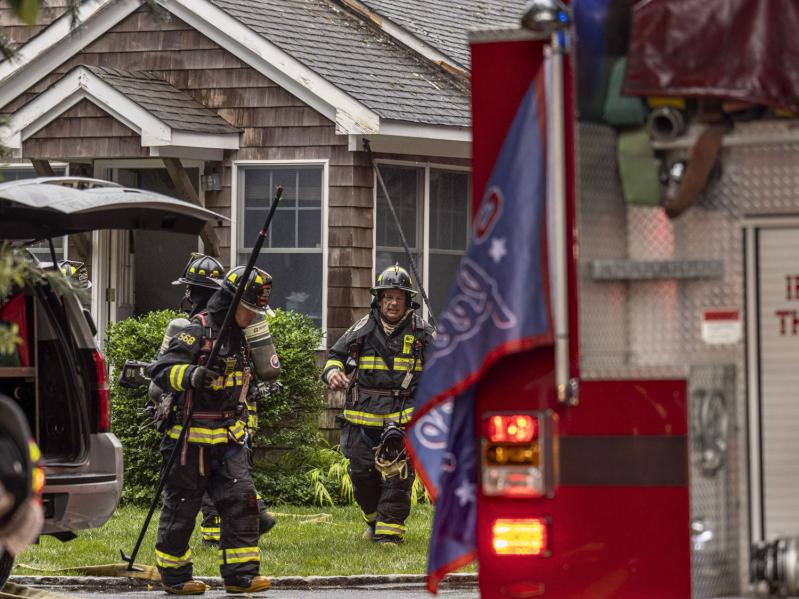Two houses in East Hampton were damaged by a lightning strike late Tuesday afternoon that sent an occupant of one to the hospital. The clap of thunder that quickly followed was so loud that it shook houses miles away.
The houses are next door to each other at 85 and 93 Three Mile Harbor Road, across the street from the Neighborhood House, and both were occupied at the time. East Hampton Fire Department Chief Duane Forrester surmised that the lightning “may have struck the ground and traveled up to the houses” through underground infrastructure, including wiring for an invisible dog fence and for sprinkler systems.
At 93 Three Mile Harbor Road, the strike “blew some of the wires through the walls, through the Sheetrock.” The occupant of that house was taken by ambulance to Stony Brook Southampton Hospital. Mary Mott, East Hampton ambulance chief, was unable to provide details about the person’s condition, and Chief Forrester said only that they may have been working at a computer near a socket at the time of the strike.
As firefighters investigated at number 93, “we pulled down some of the fascia on the roof to make sure that we didn’t miss anything,” Chief Forrester said. “We also checked other houses on either side of these two, just to make sure no other structures were affected.”
The damage at 85 Three Mile Harbor Road was minimal, he said. The strike blew a satellite dish off the roof. “It’s just gone. We have no idea where it is.” It also blew the face off an electrical box for a newly installed innovative/alternative septic system, according to the chief.
“We’ve had lightning strikes before and it will hit a point in the house and cause a small fire, but this is kind of a rarity, where we’ve had two houses affected,” he said.
Responding to calls during electrical storms requires a special set of precautions. “We don’t raise the ladder on our ladder truck,” which would act like a giant lightning rod, and “we don’t put people on roofs.”
By about 6:30 on Tuesday evening, with no other issues found, the fire department turned the scene over to the town fire marshal to investigate. The fire marshal’s office was unable to provide further information as of press time.
Tuesday’s severe weather was part of a first wave expected to bring heavy rain, flash flooding, and damaging winds to areas across New York State, from the mid-Hudson area to New York City and Long Island.
Gov. Kathy Hochul’s office on Tuesday warned people to be prepared for potential transportation disruptions, flooding, and power outages from Tuesday into yesterday, with some areas expected to “see up to five inches of rain and rainfall rates up to three inches per hour.”
More heavy rain is possible today through Saturday as Tropical Cyclone Debby moves into the area.
In an alert sent out Tuesday, the governor’s office shared safety tips to remember during thunderstorms. First among them: “If you can hear thunder, you are close enough to the storm to be struck by lightning.” In that case, take shelter immediately in a sturdy building, or, if one is not nearby, in a hard-top vehicle with the windows rolled up. Her office also reminded people that, as seen in Tuesday’s strike in East Hampton, “telephone lines and metal pipes can conduct electricity,” and that appliances should be unplugged during electrical storms.
Also worth remembering: Avoid showering or bathing during an electrical storm, and turn off air-conditioning systems, as “power surges from lightning can overload compressors.”
If you are outside and can’t get to a safe shelter, it is best to find a low area away from trees, fences, or poles that can act as electrical conductors. In the woods, however, the best shelter may be under short trees.
Finally, Governor Hochul’s office said, “If you feel your skin tingle or your hair stands on end, squat low to the ground on the balls of your feet; place your hands on your knees with your head between them; make yourself the smallest target possible, and minimize your contact with the ground.”
During flash floods, people should not try to drive to safety; “most flash flooding deaths occur in automobiles.” Flooded roads should be avoided, and if you are driving and the water begins to rise quickly around you, you should get out of the vehicle immediately. “Do not underestimate the power of fast-moving water,” the governor’s office said. “Two feet of fast-moving flood water will float your car, and water moving at two miles per hour can sweep cars off a road or bridge.”
--
Note: This article has been updated since it originally appeared online.



